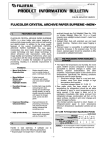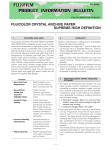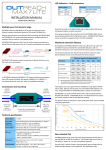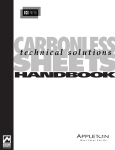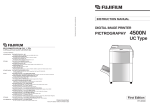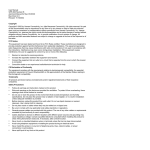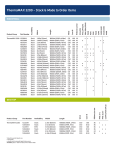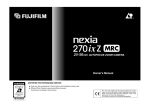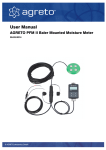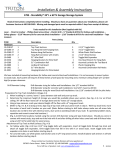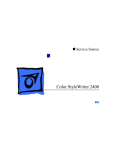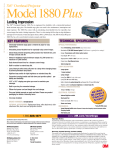Download Fujifilm 1x4 Crystal Archive 10.2 cm x 186 m, lustre
Transcript
AF3-198E COLOR NEGATIVE PAPERS FUJICOLOR CRYSTAL ARCHIVE PAPER 1. FEATURES AND USES FUJICOLOR CRYSTAL ARCHIVE PAPER is a silver halide color paper designed to produce high-image quality color prints on both analog and digital printers. This paper incorporates new silver halide emulsion technology, coupler technology and layer design technology to deliver enhanced color reproduction, white purity, image stability and handling. Furthermore, when used in conjunction with the newly developed digital minilab Frontier 5**/7**, it enables the realization of superfast processing, resulting in a dramatic improvement in productivity. Features • More Vivid Color ...... Retains beautiful colors Reproduction such as subtle shades of green, vivid blues and reds • More Brilliant ............ Whites plus Improved Highlight Details Further improved whiteness, with clearer and more distinct highlight details • Excellent Image ........ Exhibits high image Stability stability during long-term dark storage and excellent light storage stability, as well as sharply improved storability with respect to nitrogen oxide, ozone and other gases • Improved Handling ... Improved tolerance for Characteristics processing unevenness and pressure-induced density variations that sometimes occur 3. PRE-PROCESSING PAPER HANDLING/ STORAGE • The higher the temperature and humidity, the more paper, whether unused, unexposed or exposed, is susceptible to adverse changes in speed, color balance, physical characteristics and other properties. Unprocessed paper is best stored at low temperatures. Specifically, the following conditions should be used for paper storage. Short-term storage: Store in a cool and dark location, away from direct sunlight or high tem-perature and humidity Long-term storage: Below 10 C (50 F) • Raw paper which has been stored at a low temperature (by refrigeration) should be set aside and allowed to warm to room temperature prior to being opened. If the paper is taken out of its packaging immediately after being removed from refrigerated storage, condensation will form on the paper surfaces, resulting in print color changes and easily damaged surfaces. The shortest periods required to return freezer- or refrigerator-stored paper to room temperature (minimum temperature equalization periods) are as follows. 20 °C (68 °F) Temperature Equalization Periods • High productivity ...... Realizes high productivity when used in conjunction with the Frontier 5**/7** 2. Wratten Safelight Filters No. 13) in a 10-watt tungsten lamp safelight located at least 1 meter from the work area. • Safelight filters fade with extended use and need regular checking. Replace when paper fogging is detected. • Exposed paper is susceptible to safelight-induced sensitivity increases in the exposed area. For this reason, exposed paper should be subjected as little as possible to safelight illumination. Unit: hours Paper Size Storage -20 °C Temperature (-4 °F) 10.2 cm × 185.9 m (4 in. × 610 ft.) SAFELIGHT Handle in total darkness. If safelight use is unavoidable, observe the following precautions. • Expose paper no longer than 1 minute to light emitted through two Fuji Safelight Filters No. 103A (or –1– 6 0 °C 10 °C (32 °F) (50 °F) 5 3.5 NOTES • Do not heat paper in order to equalize temperatures. • Remove paper from refrigeration on day before use. FUJIFILM PRODUCT INFORMATION BULLETIN • FUJICOLOR CRYSTAL ARCHIVE PAPER • Storage in a room closet facing a wall exposed to cold outside air (which may cause condensation). • Storage in a place near the ceiling, such as an attic, the top of a closet or cupboard (where high temperatures may occur). 3 Storing prints with their front surfaces facing each other may result in unexpected problems. For this reason, prints should be stored with their front surfaces facing away from each other. If the adjacent print placement is unavoidable, it is necessary to keep the surfaces separated by, for example, the use of interleaving sheets of paper. • If exposed paper remains unprocessed for extended periods of time under normal room conditions or is subjected to high temperature and/or high humidity, changes in the color balance and other properties may occur. • The time between exposure and development should be fixed in order to obtain consistent quality. Avoid waiting until the next day to develop the exposed paper. Rather than holding the paper for processing the next day, initiate processing as soon as possible. 4. PROCESSING 6. This paper is designed for use with FUJICOLOR Paper Process CP-40FA, CP-43FA, CP-47L, CP-48S, and CP-49E, or RA-4 type processes. 5. When inspecting finished color prints, it is essential that an illumination source be used that has superior spectral characteristics, adequately high color temperature and sufficient brightness. This is because results can appear different, depending on light quality. For precise results, prints should be examined under the conditions designated by ISO 3664-2000. As a general guide, the following conditions are recommended. POST-PROCESSING PAPER (PRINT) HANDLING/STORAGE Since prints are usually used for the long-term recording of images, as much effort as possible is made to use materials that exhibit the least amount of change over time, but the effects of light, heat, oxygen in the air, contaminating gases, humidity and mold cannot be completely avoided. It is possible, however, to minimize the change in the photographic image or base material by maintaining the appropriate storage conditions for prints, such as those used by museums and art galleries. Temperature and humidity control is the most important key to minimizing the change that occurs in prints. Prints stored in the dark under the following conditions may be expected to show almost no change over time. Storage Period with Almost No Change More than 20 years 10 — 20 years Temperature Below 10°C (50°F) Below 25°C (77°F) LIGHT SOURCES FOR VIEWING Color Temperature : 5000±300 K Average Illumination : 500 Lux or more General Color Rendering Index: Ra 90 or more* * To attain these values, special fluorescent lamps designed for color evaluation (e.g. EDL type) should be used. When inspecting finished prints, be careful to shut out all external light and colored reflected light. 7. USE WITH FRONTIER 3**/5**/7** Please refer to the following calibration data as a general guide when using FUJICOLOR CRYSTAL ARCHIVE PAPER on a digital printer. Relative Humidity 30% — 50% 30% — 50% • Notes on Print Storage 1 Prints should be inserted into albums, mounted, or placed into a bag (plastic*) for photographic prints before being stored. All Frontiers requires a dedicated LUT when printing. This dedicated LUT is available on installer A3, version J and higher For availability of this CD, please contact your local distributor. *Made of polyester, polystyrene, polyethylene, or polypropylene plastic, etc. 2 Even during normal storage, it is recommended that prints be stored at a place as free as possible from hot and humid conditions, and away from direct sunlight and other strong light or from direct illumination. The following are examples of undesirable storage conditions. –2– FUJICOLOR CRYSTAL ARCHIVE PAPER • FUJIFILM PRODUCT INFORMATION BULLETIN It is necessary to adjust for the paper type for each paper magazine by changing the paper “Type” specification in the “Paper Magazine Registration” menu. <Changing Paper Type Specification of Paper Magazine for Frontier 330/350/370/390> 1 Log in to the “4 Setup and Maintenance” menu with “SE2” for the user name, and a password of “7777”. 2 Select “5 Printer Adjustment/Maintenance” – “1 Paper Magazine Registration” (Menu 451) and change the paper type to “C” as shown in the table below. Paper CRYSTAL ARCHIVE PAPER Type 8. USE WITH FA/FA COMPACT SERIES Since cyan forming dye has been modified in CRYSTAL ARCHIVE PAPER, a problem may arise when this paper is used on the printing condition settings made using the densitometer (QT-600) built into Fuji Minilab FA/FA compact series. When CRYSTAL ARCHIVE PAPER is used with FA/FA compact series of Minilabs, it is necessary to set the printing conditions using the “ring-around print” method or another densimeter. 9. C PAPER SURFACE AVAILABLE Glossy, Lustre and Matte 3 Select “2 Print Condition Setup and Check” – “1 Paper Condition Setup” (Menu 421) and perform a paper condition setup for all magazines for which the paper types were changed. * It is important to click the “Initialize” button to initialize the settings before making the paper condition setup. After initialization, the first paper condition setups will deviate by a great degree, but this will be balanced after the second or third attempt. (Please note that clicking the “Initialize” button will not be possible if you do not log in with a user name of lab administrator or higher.) <Changing Paper Type Specification of Paper Magazine for Frontier 340/355/375/500/550/570 /590> SIZES AVAILABLE • Rolls Length Width 50m 90m 186m 305m 450m 500m (164ft.) (295ft.) (610ft.) (1000ft.)(1476ft.)(1640ft.) ¸ ¸ ¸ ¸ ¸ 12.7 cm (5in.) ¸ ¸ 15.2 cm (6in.) ¸ ¸ 17.8 cm (7in.) ¸ ¸ 20.3 cm (8in.) ¸ ¸ 8.9 cm (3.5in.) 10.2 cm (4in.) ¸ 11.4 cm (4.5in.) 12.0 cm (4.7in.) Type C 3 Click the [Setup and Maintenance] – [02 Print Condition Setup and Check] – [0200 Paper Condition Setup] buttons and perform a paper condition setup for all magazines for which the paper types were changed. * It is important to click the “Initialize” button to initialize the settings before making the paper condition setup. After initialization, the first paper condition setups will deviate by a great degree, but this will be balanced after the second or third attempt. (Please note that clicking the “Initialize” button will not be possible if you do not log in with a user name of lab administrator or higher.) ¸ ¸ ¸ ¸ 11.7 cm (4.6in.) 1 Log in to the “Setup and Maintenance” with the Password “7777”. 2 Click the [Setup and Maintenance] – [02 Print Condition Setup and Check] – [0221 Paper Magazine Registration]. Change the paper type to “C” as shown in the table below. Paper CRYSTAL ARCHIVE PAPER 10. 21.0 cm (8.3in.) ¸ 24.0 cm (9.4in.) ¸ 25.4 cm (10in.) 30.5 cm (12in.) ¸ ¸ 40.6 cm (16in.) ¸ ¸ ¸ ¸ 50.8 cm (20in.) 60.3 cm (23.7in.) ¸ 76.2 cm (30in.) 106.0 cm (41.7in.) ¸ ¸ 127.0 cm (50in.) ¸ NOTES Size availability may change without prior notice. –3– FUJIFILM PRODUCT INFORMATION BULLETIN • FUJICOLOR CRYSTAL ARCHIVE PAPER 12-2 Bag Labeling • Sheets sheets/box 50 100 size 20.3 x 25.4 cm ¸ 24.0 x 30.5 cm ¸ 30.5 x 40.6 cm ¸ 40.6 x 50.8 cm 50.8 x 61.0 cm ¸ 76.2 x 102 cm ¸ 11. ¸ CONTROL STRIPS Processing control can be provided through the use of FUJICOLOR PAPER CRYSTAL ARCHIVE Control Strips - Process CP-40FA/43FA/47L/48S/49E. * When using CRYSTAL ARCHIVE PAPER, the LD value may slightly increase in control strips with some processing chemicals. However, there is no problem in processing performance. 12. MARKINGS (BOX/BAG/EMULSION NUMBERS) NOTE 13. 12-1 Box Markings 14. 12-3 Emulsion Numbers Emulsion numbering will be in ascending order from 601 (with backprint) or 701 (without backprint) at introduction. PAPER STRUCTURE –4– FUJICOLOR paper is marked with a three-digit emulsion number followed by an additional three-digit number, which is provided for production control purposes only. Should any problems arise with FUJICOLOR CRYSTAL ARCHIVE PAPER, the additional threedigit number suffix to the emulsion number should be indicated on any claim. BACKPRINTING FUJICOLOR CRYSTAL ARCHIVE PAPER • FUJIFILM PRODUCT INFORMATION BULLETIN 15. SPECTRAL SENSITIVITY CURVES 16. 0.0 Process : CP-48S Spectral Reflection Density Blue Sensitive Layer 1.0 Relative Sensitivity* Process : CP-48S Densitometry :Status A Density :1.0 above Dmin Green Sensitive Layer 1.0 Yellow Magenta Cyan 0.5 0.0 Red Sensitive Layer 400 SPECTRAL DYE DENSITY CURVES 500 600 Wavelength (nm) 400 700 700 500 600 Wavelength (nm) * Sensitivity equals the reciprocal of the exposure (J/cm²) required to produce a specified density. 17. IMAGE STORAGE CHARACTERISTICS • Estimated Light Storage Stability under 500 Lux Intermittent Illumination Conditions*** Process: CP-48S 0.9 Color Dye Fading* (Y, M and C Patches at Density of 1.0) 0.7 Recomended Long-term Storage Condition** (40% RH) CC Y M Y M High Humidity Storage Condition** (70% RH) 0.6 Stain* 1 2 10 20 50 100 200 M Y C Average light exposure: 500 Lux, 12 hours/day*** Process: CP-48S 0.6 0.5 0.4 0.3 0.2 0.1 5 1.0 0.9 0.8 Color Dye Fading* 0.7 (Color Patch at Density of 1.0) 0.6 0.2 Stain* 0.1 0.0 5 500 1000 10 15 Years Years (log scale) * ** Time-induced white background staining (yellowing) is as important as dye image fading in affecting image quality. In regard to color image dark storage stability, the level of humidity is just as important as temperature. For this reason, more accurate evaluations can be made by using the two humidity standards — one for high humidity storage conditions (70%RH) and that recommended for long-term storage (40%RH). *** Since in common domestic situations sunlit areas may be bright as 1,000 lux or more during the day and drop to 300 lux in the evening and at night, storage conditions are usually designated to be at an average of 500 lux of light exposure for 12 hours per day. –5– Density ( DB) 0.8 Density ( DB) Density (D) 1.0 Density (D) • Estimated Dark Storage Stability at 25 °C (77°F) FUJIFILM PRODUCT INFORMATION BULLETIN • FUJICOLOR CRYSTAL ARCHIVE PAPER NOTICE The data herein published were derived from materials taken from general production runs. However, changes in specifications may occur without prior notice. –6– 7-3, Akasaka 9-chome, Minato-ku, Tokyo 107-0052, Japan Ref. No. AF3-198E (updated FFME)






